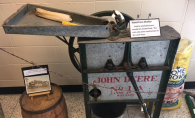Virginia Hoppenrath was 10 years old the first time she saw her wedding dress. She and her sister were singing in their aunt’s wedding. The bride had paid less than fifty dollars for the dress at Powers department store in downtown Minneapolis. It was a cream-colored gown with an intricately pearled neckline, cinched bodice, padded shoulders and dramatic train. Even then, she knew the dress would one day be hers. It was common practice, at that time, for a daughter to inherit her mother’s bridal gown. As the aunt had no children of her own, it was understood that her goddaughter, Virginia, would inherit it—an idea that always delighted her. Throughout her childhood, the dress hung, sheathed, in her godmother’s big, dark closet. Young Virginia would visit it there, feeling the smooth satin and dreaming of her own wedding day.
When that day came eight years later, Hoppenrath recalls that the dress fit remarkably well. “They [took] in the shoulders because I was smaller there, but that’s about all.” On October 4, 1947, 18-year-old Virginia Glauvitz walked down the aisle at St. Paul’s Lutheran Church in northeast Minneapolis, a bouquet of peach Talisman roses in hand, her aunt in the pews whispering “That’s my dress,” and her groom, Earl Hoppenrath, at the altar.
Sixty-seven years later, the Maple Grove Historical Preservation Society (MGHPS), of which Hoppenrath is a member, discussed themes for its second-ever exhibit at the new History Museum. When they decided to display historical wedding dresses, Hoppenrath didn’t hesitate in volunteering her own. “If it were falling to pieces, that would be a different story,” she says. All these decades later, the dress (and, for that matter, the Hoppenraths’ wonderful union) remains beautiful, as visitors to the museum this past fall may have observed.
The exhibit’s 14 dresses spanned three decades, from 1919 to the 1940s, with a preponderance of lace, satin, velvet and wispy dimensions. Caroline Schaefer, museum director, says she appreciated the diversity of styles, with everything from flapper-inspired dresses to conservative home-sewn gowns and simple war time numbers represented. While her mother’s velvet dress from 1935 is closest to her heart, Schaeffer was also drawn to a blue wool suit dress, which was worn at a “hasty” World War II wedding. Hoppenrath remembers a dress that she and the other Society ladies agreed felt just like lambs’ ears. Just as striking as the variety within the collection was one surprising commonality: the dresses’ state of preservation.
Hoppenrath’s own required nothing more than a thorough pressing; a few hours’ worth of work, which the 85-year-old happily completed herself. When she saw the result, she admits, “I was amazed.” Considering all that it had weathered, it was incredible that its sleeves and flowing train were still attached and unharmed.
“[The dress] has been wet several times,” she says, most notably when a tornado struck the Hoppenraths’ house in 1966. “Our home was destroyed. Lifted up 17 inches and set back down.” Stored in the basement in a simple cardboard box at that time, the dress was dampened but sustained no permanent damage. Regarding the satin train, Hoppenrath chuckles: “I didn’t even think [it] would survive the wedding dance; I remember it got stepped on so many times!”
Last fall’s exhibit was also an occasion for remembrance. As Schaeffer, Hoppenrath and the other society ladies prepared the display, they were compelled to talk about the ceremonies the dresses were worn to and the women who wore them, most of whom are now deceased. “It brought back the most warm, wonderful memories,” Hoppenrath says.
These days, her wedding dress dwells in a dry chest, along with a handful of formal dresses she has worn over the years, although the MGHPS display was by no means the first time she’s aired it out since her wedding day. Hoppenrath has lent the dress out on numerous occasions, including to a niece, who wore it in a high school’s period fashion show. She is considering donating the dress to an organization such as the MGHPS, the university or an acting group. “I’d rather see it used, than in a box,” she declares—a sentiment that seems perfectly aligned with the core mission of the MGHPS, now in its 21st year of existence.
Like memory itself, or love, Virginia Hoppenrath’s surprisingly resilient dress seems to be one of those rare treasures that can be shared again and again, without ever diminishing.









